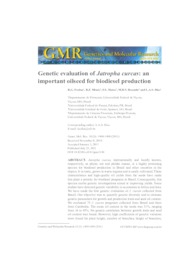Genetic evaluation of Jatropha curcas: an important oilseed for biodiesel production.
Genetic evaluation of Jatropha curcas: an important oilseed for biodiesel production.
Autoria: FREITAS, R. G.; MISSIO, R. F.; MATOS, F. S.; RESENDE, M. D. V. de; DIAS, L. A. S.
Resumo: Jatropha curcas, internationally and locally known, respectively, as physic nut and pinhão manso, is a highly promising species for biodiesel production in Brazil and other countries in the tropics. It is rustic, grows in warm regions and is easily cultivated. These characteristics and high-quality oil yields from the seeds have made this plant a priority for biodiesel programs in Brazil. Consequently, this species merits genetic investigations aimed at improving yields. Some studies have detected genetic variability in accessions in Africa and Asia. We have made the first genetic evaluation of J. curcas collected from Brazil. Our objective was to quantify genetic diversity and to estimate genetic parameters for growth and production traits and seed oil content. We evaluated 75 J. curcas progenies collected from Brazil and three from Cambodia. The mean oil content in the seeds was 31%, ranging from 16 to 45%. No genetic correlation between growth traits and seed oil content was found. However, high coefficients of genetic variation were found for plant height, number of branches, height of branches, and stem diameter. The highest individual narrow-sense heritabilities were found for leaf length (0.35) and width (0.34), stem diameter (0.24) and height of branches (0.21). We used a clustering algorithm to genetically identify the closest and most distant progenies, to assist in the development of new cultivars. Geographical diversity did not necessarily represent the genetic diversity among the accessions collected. These results are important for the continuity of breeding programs, aimed at obtaining cultivars with high grain yield and high oil content in seeds.
Ano de publicação: 2011
Tipo de publicação: Artigo de periódico
Unidade: Embrapa Florestas
Palavras-chave: Clustering, Genetic diversity, Oil content, genetic correlation, heritability
Observações
1 - Por padrão são exibidas publicações dos últimos 20 anos. Para encontrar publicações mais antigas, configure o filtro ano de publicação, colocando o ano a partir do qual você deseja encontrar publicações. O filtro está na coluna da esquerda na busca acima.
2 - Para ler algumas publicações da Embrapa (apenas as que estão em formato ePub), é necessário ter, no celular ou computador, um desses softwares gratuitos. Sistemas Android: Google Play Livros; IOS: iBooks; Windows e Linux: software Calibre.
Acesse outras publicações
Acesse a Base de Dados da Pesquisa Agropecuária (BDPA) para consultar o acervo completo das bibliotecas da Embrapa.

